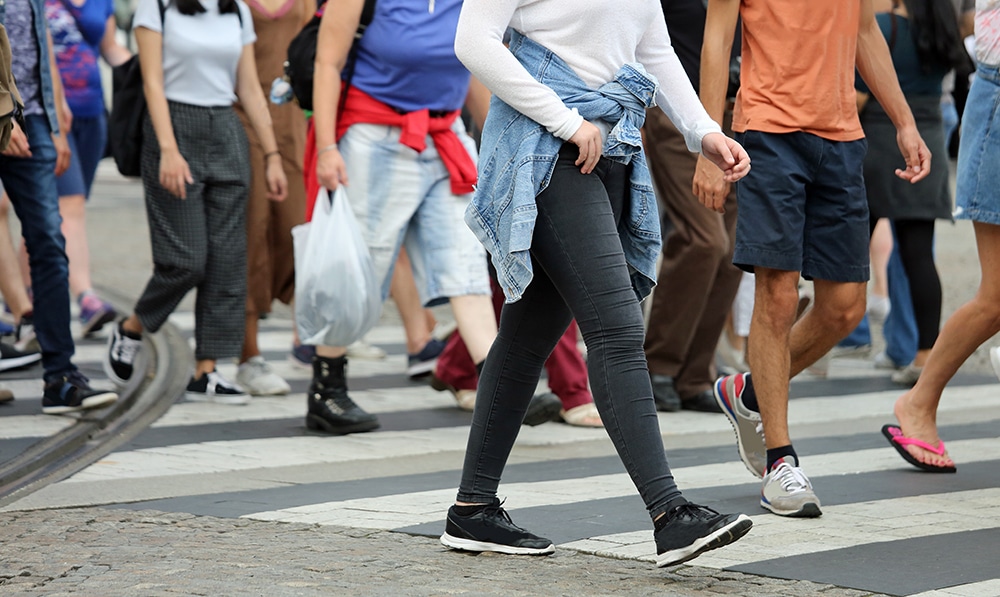Rated as both a “Walker’s Paradise” and “Rider’s Paradise” by Walk Score, Philadelphia is perhaps one of the best cities to live in and visit as a pedestrian.
The number of pedestrians is on the rise, too. After a dip in numbers caused largely by the COVID-19 pandemic, Center City District spring 2023 data shows that pedestrian levels downtown recently reached 78% of Feb. 2019 levels. In Feb. 2023, an average of 347,800 people explored downtown Philadelphia on foot each and every day.
But just because we are a pedestrian-friendly city does not mean that everyone traveling by foot or bike is protected when sharing the road with larger motor vehicles. Even one pedestrian collision is one too many, which is why Shrager, Sachs, & Blanco is eager to explore how to make Philadelphia safer for pedestrians.
The State of Pedestrian Safety in Philadelphia
Whether exploring Fairmount, strolling through Chestnut Hill, or walking in Ardmore, traveling by foot should always be a safe option. Unfortunately, even the most pedestrian-friendly neighborhoods are not risk-free. Consider the following pedestrian accident statistics for Philadelphia from 2014 to 2018:
- There were an average of 36 pedestrian fatalities per year.
- 21% of all injury crashes involved at least one pedestrian injury.
- Our city had a higher pedestrian accident rate than the rest of Pennsylvania.
- Pedestrian deaths represented 41% of all crash fatalities despite representing only 8% of people involved in crashes.
Even after earning a reputation as a pedestrian-friendly city, the reality that walkers face when traveling through Philadelphia often tells another story. Any time that a person is forced to cross or share the road with motor vehicles, there is the potential for a serious or even deadly accident to occur.
Taking a Systemic Approach to Pedestrian Safety
Vision Zero Philadelphia, a government program aimed at “eliminating traffic fatalities and serious injuries by 2030,” outlines a systemic approach to safety. According to the Federal Highway Administration (FHA), this involves using “widely implemented improvements based on high-risk roadway features correlated with specific severe crash types.”
A systemic approach to safety is associated with a broadening of safety implementations with little to no extra cost.
Under the current goals and policy recommendations set forth by Vision Zero Philadelphia, the following changes could have a profound impact on making Philadelphia safer for pedestrians:
- Designing residential roads with traffic-calming measures to meet targets for 20 mph speed limits.
- Implementing new traffic-calming designs on arterial roads in an effort to lower traffic speeds.
- Retiming traffic signal progressions to better support lower, safer speeds for vehicles.
- Implementing pedestrian count-down timers at crosswalks and adjusting timers to be safe, understandable, and consistent across different areas of the city.
- Creating and maintaining traffic gardens at city schools, giving children the opportunity to learn walking and biking habits that will keep them safe.
City-wide systemic approaches are only effective when both pedestrians and drivers follow the rules of the road and act in a way that respects the safety of everyone around them.
Top 5 Pedestrian Safety Tips
Compared to big cars, trucks, SUVs, and vans, pedestrians have little to no protection in an accident. To reduce the risk of injury or death, every pedestrian should follow our top 5 pedestrian safety tips:
- Always use sidewalks and pedestrian paths when available. When there are none, walk on the shoulder or far side of the road facing traffic.
- Always cross at designated pedestrian crossings when available. When there are none, cross at intersection corners.
- Always look both ways before crossing, and listen for approaching vehicles if your view is obstructed.
- Avoid wearing headphones, especially when crossing the road or walking in the roadway.
- When walking at night, wear brightly colored clothing, reflective vests or belts, or use your phone’s flashlight function to make yourself visible to drivers.
It’s important to note that while these safety tips can reduce your risk of being involved in an accident, they cannot set your chance of being hit by a driver to zero. You can do everything right and still be involved in a crash due to the negligent or reckless actions of a driver.
Why Are Pedestrian Accidents So Serious?
A motor vehicle occupant has a seat belt, airbags, and the frame of the vehicle to help limit their risk of serious injury in an accident. A pedestrian has nothing.
When a collision occurs between a motor vehicle and a pedestrian, it is most often the pedestrian who will suffer the greatest and most severe injuries. Part of this phenomenon comes down to the types of vehicles that are most popular right now.
According to the Insurance Institute for Highway Safety (IIHS), fatal single-vehicle crashes involving pedestrians shot up by 81% between 2009 to 2016. IIHS also points to earlier research that shows that pedestrians are two to three times more likely to die in accidents involving SUVs, passenger vans, and pickup trucks.
These types of motor vehicles tend to be designed with higher front ends. When a small car hits a pedestrian, it typically strikes them in the legs or at waist level. SUVs and vehicles with high front ends typically hit pedestrians in the chest or abdomen, causing injuries that are much more likely to be fatal.
Steps To Take After a Pedestrian Accident
If you’ve been involved in a pedestrian accident, you already know just how much is on the line. You may be missing work while you rest and recover, which is the best thing for your body. Unfortunately, if you’re not working, you may not be earning enough to cover your medical bills and daily expenses. This type of situation can leave victims feeling desperate, and some even return to work before their bodies have had a chance to fully recover.
You shouldn’t have to sacrifice your physical, emotional, and financial well-being because of another person’s negligent actions.
While experts continue to focus on efforts to make Philadelphia safer for pedestrians, you need help now.
For an opportunity to learn about your right to recover compensation after a pedestrian accident, please contact Shrager, Sachs, & Blanco by phone or online to schedule a free consultation.









